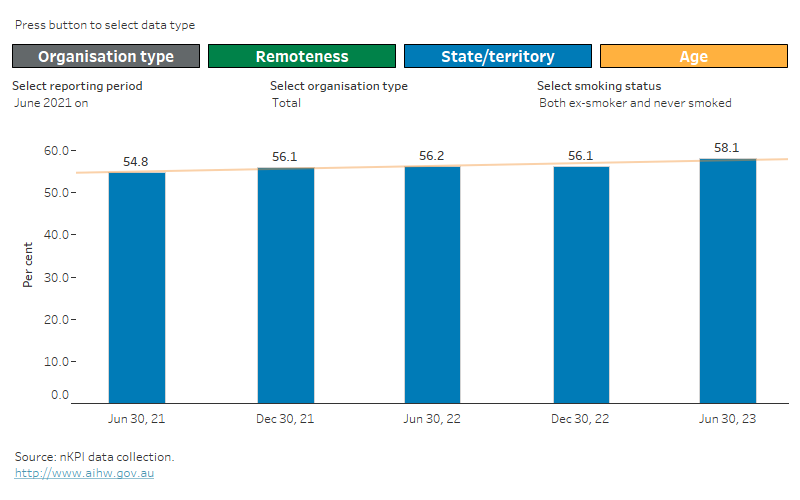Smoking during pregnancy (PI11)
This indicator is the proportion of female First Nations regular clients who gave birth within the previous 12 months and whose smoking status recorded during pregnancy was:
- current smoker
- ex-smoker
- never smoked.
It is collected for age groups:
- less than 20
- 20–34
- 35 and over.
There have been changes to the specification of this indicator over time. For more information see Interpreting nKPI data.
Indicators related to smoking for ages 11 and over are also collected, with data presented under the Preventative health domain.
Why not smoking during pregnancy is important
Tobacco smoking is the smoking of tobacco products, including packet cigarettes, roll-your-own cigarettes, cigars or pipes.
Tobacco smoking during pregnancy is the most common preventable risk factor for pregnancy complications, and is associated with poorer perinatal outcomes, including low birthweight, being small for gestational age, pre-term birth and perinatal death. Women who stop smoking during pregnancy can reduce the risk of adverse outcomes for themselves and their babies.
The targets in the National Agreement on Closing the Gap include several aimed at children, including a target to increase the proportion of First Nations babies with a healthy birthweight to 91% by 2031 (with smoking during pregnancy as a supporting indicator).
Data from the National Perinatal Data Collection show that the proportion of First Nations mothers who smoke during pregnancy has decreased over time. First Nations mothers, however, are more likely to smoke during pregnancy than non-Indigenous mothers (AIHW 2023).
At June 2023, 42% (or around 2,100) of female First Nations regular clients who gave birth within the previous 12 months smoked at some point during pregnancy, 42% (2,100) had never smoked and 16% (770) were ex-smokers (Figure 1).
Figure 1: Smoking status during pregnancy by reporting period
Smoking during pregnancy by reporting period
This Tableau visualisation shows the percentage of First Nations regular clients who gave birth in the last year by their smoking status in the last year (select for current smoker, ex-smoker, or never smoked) and reporting period. There are two tabs with different time periods:
- June 2021 to June 2022
- June 2017 to December 2020.
Data supporting this visualisation are available in Excel supplementary data tables at Data.

Notes
- In June 2021, specifications changed for this indicator and data from that point on cannot be compared with previous periods. For more information see Interpreting nKPI data.
- For more information, including on interpreting changes over time, see Technical notes.
For more information on smoking during pregnancy see Data.
Reference
AIHW (Australian Institute of Health and Welfare) (2023) Aboriginal and Torres Strait Islander Health Performance Framework: health behaviours during pregnancy, AIHW, Australian Government, accessed 11 December 2023.


